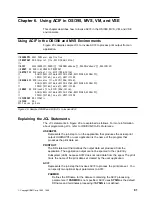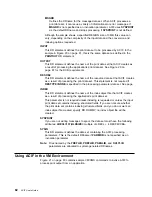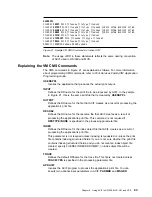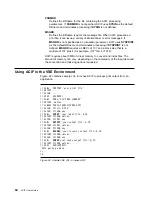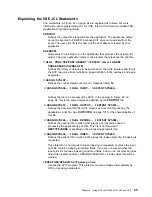
applications that use a specific carriage control character to define page
boundaries (for example, skip to channel 1), consider defining the value of
the carriage control character as one of the TRIGGERn parameters. The
supported range of values for
column are 1–32 756. If the specified value
exceeds the physical length of the record, ACIF reports an error condition
and terminates processing.
length
Specifies the number of contiguous bytes (characters) starting at
column
that compose this field. The supported range of values for
length is 1–250.
The field can extend outside the record length, as long as the column
where it begins lies within record length. In this case, ACIF adds padding
blanks (X
'
40
'
) to fill out the record. If the field begins outside the maximum
length of the record, ACIF reports an error condition and terminates
processing.
{
‘literal value’ | X
'
literal value
'
}
Specifies the literal (constant) value of the FIELDn parameter. This value
can be specified either as character data or as hexadecimal data. The
literal value can be 1–250 bytes in length. ACIF does not perform any
validity checking on the actual content of the supplied data.
EXAMPLE
FIELD1=ð,2,2ð
FIELD2=5,5,1ð
FIELD3=–15,3ð,5
FIELD4=‘444663821’
FIELD5=X'ððð1'
The first field in the example is located in the indexing anchor record
(TRIGGER1). It is 20 bytes in length, starting at the second byte of the
record. The second field is located five records down from the indexing
anchor record. It is 10 bytes in length, starting at the fifth byte of the record.
The third field is located 15 records before the indexing anchor record. It is
5 bytes in length, starting at byte 30. The fourth and fifth fields are literal
(constant) values. One is specified as character data (for example,
EBCDIC), and the other is hexadecimal data.
ACIF allows fields to be defined but never referenced as part of an index.
Because ACIF requires either a field or TRIGGER to appear on the first
page of a logical document, unless the INDEXSTARTBY parameter is
used, you can satisfy this requirement by defining a “DUMMY” field. This
DUMMY field allows ACIF to determine the beginning page of a logical
document, but it is not used as part of an index. If you specify the
INDEXSTARTBY parameter, start counting on the first page on which you
have a valid field, not a DUMMY field.
|
FONTECH=
unbounded
|
Indicates that ACIF should process 3800 or unbounded box fonts.
|
FONTLIB=
data set name1[,data set name2][,data set name...]
(OS/390 and
|
MVS)
|
Specifies the data sets that compose the font library. A maximum of 8 data sets
|
can be specified. This parameter also specifies the concatenation sequence
|
when ACIF searches for a particular font resource. ACIF first looks for the
|
resource in
data set name1. If it cannot find the resource in data set name1, it
94
ACIF User’s Guide
Summary of Contents for S544-5285-01
Page 1: ...IBM Print Services Facility IBM AFP Conversion and Indexing Facility User s Guide S544 5285 01...
Page 2: ......
Page 3: ...IBM Print Services Facility IBM AFP Conversion and Indexing Facility User s Guide S544 5285 01...
Page 10: ...viii ACIF User s Guide...
Page 22: ...2 ACIF User s Guide...
Page 40: ...20 ACIF User s Guide...
Page 41: ...Part 2 Using ACIF in the AIX Environment Copyright IBM Corp 1993 1999 21...
Page 42: ...22 ACIF User s Guide...
Page 72: ...52 ACIF User s Guide...
Page 96: ...76 ACIF User s Guide...
Page 99: ...Part 3 Using ACIF in the OS 390 MVS VM and VSE Environments Copyright IBM Corp 1993 1999 79...
Page 100: ...80 ACIF User s Guide...
Page 106: ...86 ACIF User s Guide...
Page 134: ...Figure 24 Example of a Customer s Phone Bill 114 ACIF User s Guide...
Page 142: ...122 ACIF User s Guide...
Page 196: ...176 ACIF User s Guide...
Page 197: ...Part 4 Appendixes Copyright IBM Corp 1993 1999 177...
Page 198: ...178 ACIF User s Guide...
Page 206: ...186 ACIF User s Guide...
Page 210: ...190 ACIF User s Guide...
Page 226: ...206 ACIF User s Guide...
Page 253: ......


